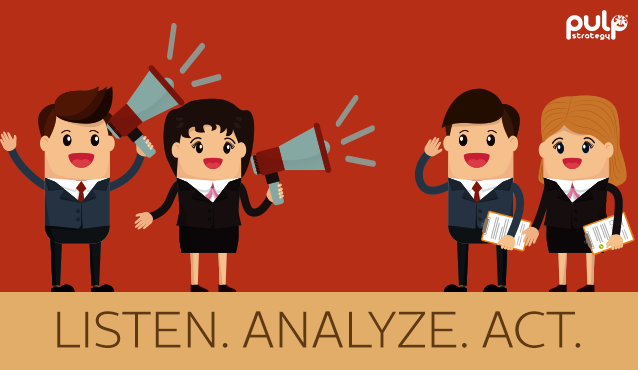Much has been said about what to write on social media platforms, but have you ever wondered what you can hear through these platforms?
Though listening is not a traditional step in a content marketing strategy, marketers have started to view it as an important step while planning, analyzing and measuring their campaigns. You listen, you track brand mentions and sentiments, and you see how these metrics behave over time.
But brands that build value and generate ROI with social media listening go beyond passive tracking—they base their strategy on specific business goals, collect data intelligently, and know how to act in a result-oriented manner.
Social Listening: Turning conversations into actionable insights
The goal of social listening is not just to research and identify how consumers perceive your brand on social media but to provide actionable insights as a foundation for impactful campaigns. It’s half awareness and half response—the response part is critical.
The evolution of Mercedes-Benz into CLA class was backed by strong insights of the target audience preference built through strategic listening. The result? A more affordable and well-received product in the market.
This proves that listening as a practice precedes every marketing activity- from product conception to tracking the results of promotions.
Here are some more reasons why your marketing team should be listening to social media conversations around your brand and industry right now:
1- Predictive Analysis: To build content that compels
Imagine the clarity that follows when you get answers to questions like:
Where did my consumers hear about me?
Which platform delivers better?
Which type of content drove engagement?
What does my audience care about?
Your editorial calendar is craving to be fed with content that your customers love to consume. The listening tool set to process the social conversations around the topics of your concern, can come back with a precise word cloud of consumer preference, behavior and grievance. What next? Create beautiful, superbly connecting content pieces that will tell your audience that you know what they are thinking, and you have just what they need. Eventually, you’ll have them remember you long after the campaign is over.
Intelligence gathered from listening can help your content team develop content, tailor-made for your audience. Listening includes predictive analytics that uses data mining and behavioral research to foretell trends that have the potential to be translated into effective content pieces. Similarly, sentiment analysis applied to social media data is another example of capturing insights that can be used to help drive marketing campaigns loved by consumers (and stay away from what puts ‘em off).
2- Identifying key brand advocates
Word-of-mouth advertisement still remains the oldest and the most effective way for brands to engage with consumers. Many may feel that it’s the word that attracts the audience but sometimes it’s the mouth that does it better.
Social media listening can enable you to profile your existing audience, and look for customers, prospects, partners and potential advocates. You’ll also start identifying key influencers—people who already love your brand and trigger positive sentiments on social media. It’s worthwhile to also monitor which influencers are following and engaging with your competitors.
3- Consumer-perception is brand-reality
By monitoring important keywords related to your industry, you can start uncovering conversations people are having about your products, services, and features that aren’t working for them—which you can funnel straight through to your product development team. People tend to go-through product reviews from blog, forums and social media before making a decision on what to purchase. You can’t stop social media users from talking about your company, but you have an opportunity to steer the conversation towards a positive direction. Remember, your customers may use social media to vent out. They may or may not care to use your handle and talk directly to you while complaining. This is where listening would play a huge role for you. It will track conversations about your brand, no matter where they are in the whole world (wide web). And you know what to do next. Put out the spark, before it turns into a wildfire.
A quick response is important to build your online reputation. Online Reputation Management enables you to improve customer feedback about your brand and generate brand visibility.
Businesses can’t afford to tune out of social channels even for an instant. Social listening is required to stay on top of consumers’ shifting preferences and to spot problems early on. With insights from listening, you can turn consumer conversations into knowledge – and let it guide you to become one of their favorite brands.
4- Measure ROI on marketing campaigns
The measurement of return on investment (ROI) has been a constant challenge. Social media listening ROI needs to be measurable in relation to key business activities such as, informing the best time for a product launch, measuring intent to purchase etc.
Social listening enables brands to monitor the impact that a campaign is having or has had. By learning about what was and wasn’t received well, marketers can optimize future campaigns, streamline operations and save money.
Tupperware worked with Pulp strategy to spread awareness about their Time Saver and Fridge product range. Our listening team analyzed the rise and drop in user engagement over the course of the campaign. Instant replies to customer queries led to increased engagement and interactions on the campaign’s social media page. Bounce rate reduced by 25%. Read more about the campaign here:
5- Now what your competition’s upto
The smartest brands are the ones whose eyes aren’t just focused on the prize but on those around them. By using social media listening strategies, you can gain so much more than a hunch about your competitors’ tactics.
Listening to competitors helps paint a fuller picture of both positive and negative social media conversations within the industry and provides insights into the content competitors are creating.
Let’s face it: it’s a lot less painful to learn a hard lesson by watching your competitors make a mistake than by making it yourself. Social monitoring identifies your competitors’ weaknesses as well as their strengths. If you find, for example, that your main competitor has a very strong presence on Facebook but hasn’t done much on Twitter, this may be an opportunity for you to dominate on this platform.
Social listening is an activity that is rich with insights relevant to every area of your business. By keeping tabs on what's being said about your brand, you can improve your interactions and build a positive brand image on the social media, which goes a long way in establishing your brand as a major industry force.
Social intelligence gives marketers the ability to understand, improve, predict, the efficiency of marketing efforts. A qualified digital intelligence team helps marketers address inefficiencies in their marketing strategy and discover new opportunities. Your listening team will mine complex data for you and process it into neat, organized and easy-to-understand reports that tell you exactly what works and what doesn’t with people you’re selling to.
For updated actionable marketing insights to optimize your marketing strategy, get in touch.






